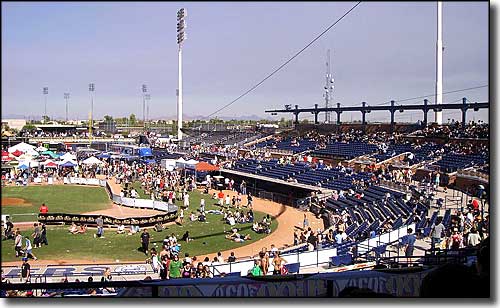
Peoria, Arizona

The Peoria Sports Complex, a venue that also hosts festivals, business events, concerts, weddings and boat tours
Peoria is a suburb on the northwest side of Phoenix. Peoria straddles the county line between Maricopa and Yavapai counties, with the majority of town in Maricopa County. The Peoria Sports Complex is the spring training home of the Seattle Mariners and the San Diego Padres. Money Magazine listed Peoria in their "Top 100 Places to Live" list in July, 2008.
Peoria was named for the city of Peoria, Illinois, original hometown of many of the earliest settlers. The settlement at Peoria was made possible through the development of large irrigation canals in the area that turned the formerly barren desert into fertile farmland. In the beginning, the settlement of Peoria was 14 miles northwest of Phoenix and could be reached only by traveling part of the road linking Phoenix with the Hassayampa River gold mining region (near present-day Wickenburg). In 1887, a 100'-wide route named Grand Avenue was laid out and stretched from Phoenix through Alhambra, Glendale and Peoria to reach the site of the Vulture Mine (the largest gold diggings near Wickenburg).
In the early days, business in Peoria centered around farming and ranching. A small business district was developing but most of the buildings were constructed of wood and tin. In July, 1917. a fire started that burned down the entirety of peoria's business district, including several newly constructed brick buildings. As the US had just entered World War I, the prices for agricultural goods rose quickly and Peoria's business owners rushed to build new, better constructed stores and warehouses to take advantage of the farmers' and ranchers' new prosperity. A local Chamber of Commerce was formed in 1919 and that body operated as Peoria's informal government until the city was incorporated in 1954.
Peoria grew slowly but steadily as an agricultural center up until the end of World War II. At the time of Peoria's incorporation, there were 1,925 residents. The post-war construction boom and the growth of nearby Luke Air Force Base made Peoria into the suburb of Phoenix that it is today.
One key element in the economic growth of Peoria has been the Peoria Economic Development Group (PEDG). The PEGD was instrumental in building Peoria's first ice-skating facility, Class A office space and modern movie theater (all in the mid-1980's). The $30 million municipal complex broke ground in 1988 at the edge of Peoria's Old Town. The Police station opened in 1989, city hall and the courthouse in 1991 and the new library in 1993. At the same time, the city was investing heavily in the construction of the Peoria Sports Complex. Construction was approved in 1990 and the Complex opened for business in 1994. Since 2004, Peoria has been able to designate more than 4,000 acres of open space and mountain preserves for use by all the residents.
Zip Codes: 85345, 85380-85382, 85385
Latitude: 33.5824°N
Longitude: 112.2385°W
Incorporated: June 7, 1954
Elevation: 1,142'
Education:
High School or Higher: 88.3%
Bachelor's Degree or Higher: 21.7%
Graduate or Professional Degree: 6.5%
2011 Cost of Living Index for Peoria: 93.5
Estimated Median Household Income: $61,600
Estimated Median Home Value: $198,400
Median Resident Age: 35.6 Years
Major Industries:
Government, Construction, Professional Services, Lodging & Food Services, Educational Services, Health Care, Finance & Insurance Services, Waste Management Services
Unemployed (March 2011): 6.1%
2010 Population Demographics
| Total Population | 154,065 |
| Males | 73,916 |
| Females | 80,149 |
| Population by Age | |
| Under 18 | 40,080 |
| 18 & over | 113,985 |
| 20-24 | 8,790 |
| 25-34 | 17,844 |
| 35-49 | 33,541 |
| 50-64 | 27,590 |
| 65 & over | 22,046 |
| Population by Ethnicity | |
| Hispanic or Latino | 28,629 |
| Non Hispanic or Latino | 125,436 |
| Population by Race | |
| White | 126,584 |
| African-American | 5,182 |
| Asian | 4,971 |
| Native American | 1,471 |
| Hawaiian or Pacific Islander | 221 |
| Other | 10,851 |
| Two or more | 4,785 |
